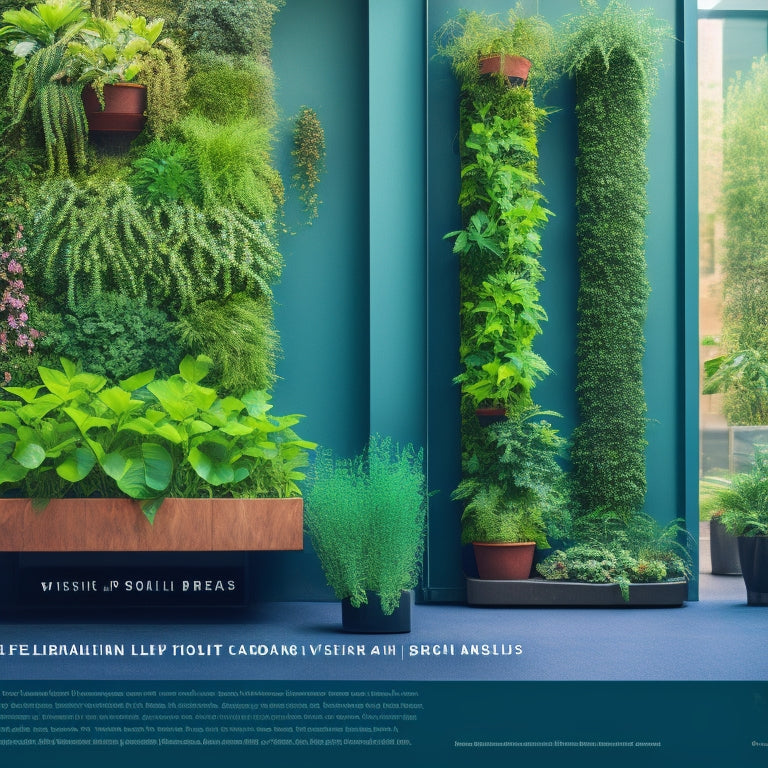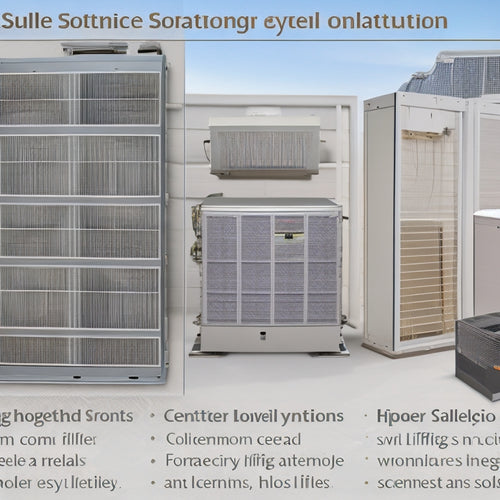
What Soil Blends Optimize Vertical Garden Efficiency?
Share
As you design your vertical garden, you're likely wondering what soil blends will enhance its efficiency. A well-balanced mix with perlite or vermiculite for drainage, rich humus content for nutrient stability, and a pH between 6.0 and 7.0 for ideal growth is essential. Additionally, incorporating renewable energy sources, aerating the soil, and maintaining microbial life will enhance sustainability. By considering your local climate, composting, and recycling, you can create a customized blend that promotes healthy plant growth while minimizing environmental impact. By examining these key factors, you'll be well on your way to crafting the perfect soil blend for your vertical garden, and there's more to investigate to achieve maximum efficiency.
Key Takeaways
- A well-draining mix with perlite or vermiculite prevents waterlogging and supports weight and density of plants effectively.
- Rich humus content and balanced nutrient profile ensure macronutrients and micronutrients availability for optimal plant growth.
- Aeration and oxygen flow are critical for root respiration and nutrient uptake, maintained by soil structure with varying particle sizes.
- Customizing soil blends by climate, incorporating native materials, and making seasonal adjustments optimize nutrient availability for plant health.
- Cost-effective and eco-friendly options like recycled materials, compost, and coconut coir contribute to overall environmental sustainability and garden efficiency.
Soil Composition for Vertical Gardens
When designing a vertical garden, the soil composition is critical, as it directly impacts the health and sustainability of the plants.
You'll want to select a soil blend that caters to the unique requirements of vertical gardening. Consider the soil types that will support the weight and density of your plants. For instance, a well-draining mix with a high proportion of perlite or vermiculite will prevent waterlogged soil and guarantee healthy root growth.
Furthermore, integrating energy-efficient practices, such as solar-powered solutions, can further enhance the sustainability of your vertical garden.
Additionally, you'll need to balance planting density with soil volume to prevent overcrowding and promote air circulation.
Organic Matter and Nutrient Balance
As you design your vertical garden's soil blend, you'll want to prioritize rich humus content, which provides a stable source of nutrients and improves soil structure.
A balanced nutrient profile is also essential, ensuring your plants receive the necessary macronutrients and micronutrients for ideal growth.
By incorporating renewable energy sources, such as solar-powered fast charging into your garden's infrastructure, you can reduce your carbon footprint and create a sustainable environment.
Rich Humus Content
You'll want to aim for a soil blend with at least 20% rich humus content to create a thriving vertical garden.
Humus is the foundation of a healthy soil ecosystem, providing numerous benefits. It improves soil structure, increases water retention, and supports beneficial microbial activity. Rich humus content also promotes healthy root growth, allowing your plants to absorb essential nutrients efficiently.
Furthermore, just like solar-powered EV charging reduces grid reliance and carbon footprint, a high humus content in your soil blend reduces the need for frequent watering and fertilization, making your vertical garden more sustainable.
You can source humus from compost, peat moss, or worm castings. When selecting a soil blend, look for products that incorporate these humus sources.
A high humus content guarantees your vertical garden will thrive, giving you the freedom to grow a diverse range of plants with minimal maintenance.
Balanced Nutrient Profile
Your vertical garden's soil blend should boast a balanced nutrient profile, achieved by striking a delicate balance between organic matter and nutrient availability.
This balance is essential for ideal plant growth and nutrient cycling. As fleets shift to renewable energy, they can reduce their greenhouse gas emissions and contribute to a more sustainable future climate action.
Similarly, a balanced nutrient profile in your soil blend can lead to a significant reduction in waste and a more sustainable gardening practice.
To accomplish this balance, consider the following key factors:
-
Nutrient-rich organic matter: Incorporate compost, worm castings, or other nutrient-dense amendments to provide a slow release of nutrients.
-
Balanced NPK ratio: Confirm your soil blend has an ideal nitrogen-phosphorus-potassium ratio to support plant growth and development.
-
pH buffering capacity: Include ingredients like peat moss or coconut coir to regulate soil pH and prevent sudden fluctuations.
- Micronutrient availability: Add soil amendments like kelp meal or alfalfa meal to provide essential micronutrients for plant health.
Water Retention and Drainage Needs
When designing your vertical garden's soil blend, you'll need to take into account the moisture holding capacity to guarantee plants receive the right amount of water.
A balanced drainage system is equally vital to prevent waterlogged soil and root rot. By striking the right balance between water retention and drainage, you'll create an ideal environment for healthy plant growth.
Integrating solar power systems, like those used in solar EV charging, can also reduce your garden's carbon footprint. This sustainable approach can lead to a significant reduction in greenhouse gas emissions and improved local air quality.
Moisture Holding Capacity
Ideal soil blends for vertical gardens must strike a delicate balance between water retention and drainage, as this equilibrium directly impacts plant health and growth.
You'll want to optimize moisture holding capacity to guarantee your plants receive the right amount of water without drowning.
To achieve this balance, consider incorporating these soil additives for improved moisture retention:
- Peat moss: Increases water-holding capacity and reduces soil density.
- Compost: Enhances soil structure and promotes healthy microbial activity.
- Vermiculite: Improves aeration and moisture retention while reducing soil compaction.
- Hydrogels: Absorbs excess water, reducing runoff and guaranteeing consistent moisture levels.
Balanced Drainage System
In addition to enhancing moisture holding capacity, a balanced drainage system is essential for vertical gardens, as it guarantees that excess water is efficiently removed to prevent waterlogged soil conditions.
You'll want to implement effective drainage strategies to make certain your plants receive the right amount of water without drowning them.
In vertical planting, gravity can work against you, making it more challenging to remove excess water. To combat this, incorporate materials with high drainage rates, such as perlite or vermiculite, into your soil blend.
These materials will help prevent water from accumulating in the soil, allowing your plants to breathe and thrive.
Aeration and Oxygen Flow Importance
As you design your vertical garden, a critical consideration is the aeration and oxygen flow within your soil blend, since roots rely on oxygen to respire and uptake essential nutrients.
Ideal aeration techniques guarantee healthy root development, allowing your plants to thrive. To achieve this, focus on the following key aspects:
-
Soil structure: Incorporate materials with varying particle sizes to create a well-balanced blend, allowing for efficient oxygen delivery.
-
Porosity: Confirm your soil blend has sufficient pore space to facilitate air movement and oxygen exchange.
-
Air pockets: Create small air pockets within the soil to maintain oxygen availability and prevent waterlogging.
- Moisture management: Implement a moisture management system to prevent waterlogging, which can lead to reduced oxygen availability.
Ph Levels for Optimal Growth
Harmony between your plants' roots and the surrounding soil is vital, and pH levels play an important role in this delicate balance.
As you fine-tune your vertical garden, it's important to understand the significance of pH balance techniques. Most plants thrive in a slightly acidic to neutral soil pH, ranging from 6.0 to 7.0.
If your soil is too acidic or alkaline, nutrients become unavailable, hindering growth. Regular nutrient testing helps you monitor pH levels and adjust your soil blend accordingly.
Microbial Life and Soil Health
A thriving vertical garden relies on a complex network of microorganisms living in the soil, with a single teaspoon of healthy soil hosting up to one billion microbe cells.
You want to create an environment that encourages microbial diversity, as a balanced ecosystem is key to plant growth. To achieve this, you'll need to incorporate soil amendments that provide nutrients and optimize soil structure.
Here are some essential considerations:
-
Microbe-friendly pH: Maintain a slightly acidic to neutral soil pH (6.0-7.0) to support microbial activity.
-
Nutrient-rich additives: Use organic matter like compost, manure, or peat moss to provide essential nutrients for microbes.
-
Aeration and drainage: Guarantee good soil structure with adequate aeration and drainage to prevent waterlogging, which can harm microorganisms.
- Minimal chemical use: Avoid using chemical pesticides, fungicides, or fertilizers that can harm or kill beneficial microbes.
Composting and Recycling Benefits
You've likely invested time and resources into creating a balanced ecosystem for your vertical garden, and now it's time to investigate the benefits of composting and recycling.
By adopting these practices, you'll reveal a wealth of advantages that'll take your vertical garden to the next level.
Composting benefits include reduced waste, improved soil structure, and increased microbial life.
Recycling techniques can help you repurpose organic matter, reducing the need for external fertilizers and minimizing your environmental footprint.
Customizing Soil Blends by Climate
By the time you've settled on a composting and recycling strategy, it's essential to turn your attention to customizing soil blends to suit your vertical garden's climate. This guarantees your plants receive the right nutrients and support to thrive in their environment.
-
Assess your local climate: Understand the temperature, humidity, and precipitation patterns in your area to determine the ideal soil blend components.
-
Make seasonal adjustments: Adapt your soil blend to accommodate changing weather conditions, such as adding more organic matter for winter insulation or increasing aeration for summer heat.
-
Incorporate local adaptations: Use native materials and plants to create a soil blend that mimics the natural ecosystem, promoting biodiversity and resilience.
- Monitor and adjust: Continuously observe your plants' response to the customized soil blend and make adjustments as needed to maintain ideal growth and health.
Cost-Effective and Eco-Friendly Options
Most vertical gardeners allocate a significant portion of their budget to soil blends, but it's possible to create a thriving garden without breaking the bank.
You can optimize your vertical garden's efficiency by selecting cost-effective and eco-friendly soil blends made from sustainable materials. Conduct a cost analysis to identify the most affordable options that meet your garden's specific needs.
Consider using recycled materials, like coconut coir or compost, which aren't only budget-friendly but also environmentally sustainable.
Frequently Asked Questions
Can I Use Regular Potting Soil in a Vertical Garden?
You can't simply use regular potting soil in a vertical garden, as it won't provide the necessary aeration, drainage, and water retention for ideal growth; instead, you'll need a mix specifically designed for vertical gardening that addresses these unique challenges.
How Often Should I Replace the Soil in My Vertical Garden?
You'll need to replace the soil in your vertical garden every 1-3 years, depending on factors like plant type and growth rate, to maintain ideal soil health and guarantee efficient water absorption, a vital aspect of vertical garden maintenance.
Are Vertical Garden Soil Blends Suitable for Indoor Gardens?
You're wondering if vertical garden soil blends are suitable for indoor gardens. Don't worry, they're perfect! These blends are designed for indoor plant care, ensuring excellent soil drainage, which is essential for healthy root growth, and ultimately, thriving plants that bring you freedom and joy.
Can I Mix My Own Soil Blend for a Vertical Garden?
You can create your own soil blend for a vertical garden by carefully controlling soil composition and incorporating effective drainage techniques, ensuring ideal water flow and aeration for healthy plant growth.
Do Vertical Garden Soil Blends Work for Rooftop Gardens?
Imagine a skyscraper built on a foundation of quicksand - it's a recipe for disaster. Similarly, your rooftop garden needs a soil blend that won't collapse under its own weight; look for blends with advanced drainage solutions and superior nutrient retention to guarantee a thriving oasis.
Related Posts
-

Why Solar HVAC Filters Revolutionize Home Energy Efficiency
By adopting solar HVAC filters, you're shifting your home's energy reliance from fossil fuels to clean, renewable sou...
-

Why Biodegradable Dish Soap Matters for Earth-Conscious Homes
You likely don't realize that the dish soap you're using today will still be harming the environment long after you'v...
-

5 Ways Geothermal Power Boosts Electric Vehicle Efficiency
You're likely unaware that geothermal power can greatly enhance your electric vehicle's (EV's) performance, range, an...


